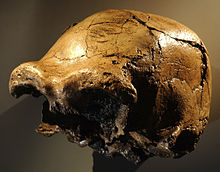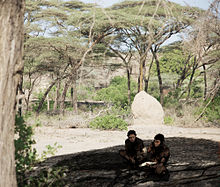- Daka skull
-
The Daka Calvaria (a skull cap with the cranial base), specimen number BOU-VP-2/66, is a Homo erectus specimen from the Daka Member of the Bouri Formation in the Middle Awash Study Area of the Awash valley of the Ethiopia Rift.[1][2] It was discovered in 1997 by Henry Gilbert. With it are several other Homo erectus specimens (leg bones, cranial fragments, and a toothless mandible), a large assortment of Acheulean industry stone tools,[3] and several hundred animal fossils.[4] The locality dates to about 1 million years old.
The Daka Calvaria has a cranial capacity of 995 cc (for reference, a chimp has about 375cc and a human about 1,400).Data from the Daka Member are published in journal articles, 2 monographs, and a fossil image database.
References
- ^ Asfaw, B., Gilbert, W. H., Beyene, Y., Hart, W. K., Renne, P. R., WoldeGabriel, G., et al. (2002). Remains of Homo erectus from Bouri, Middle Awash, Ethiopia. Nature, 416(6878), 317-320.
- ^ Gilbert, W. H., & Asfaw, B. (2008). Homo erectus: Pleistocene evidence from the Middle Awash, Ethiopia (Vol. 1): Univ of California Pr.
- ^ de Heinzelin, J., Clark, D., Schick, K., & Gilbert, H. (2000). The Acheulean and the Plio-Pleistocene deposits of the Middle Awash Valley Ethiopia. Publisher: Dept. of Geology and Mineralogy, Royal Museum of Central Africa in Tervuren, Belgium.,
- ^ http://middleawash.berkeley.edu/middle_awash/specimen_db/query.php
Categories:- Hominin fossils
Wikimedia Foundation. 2010.


